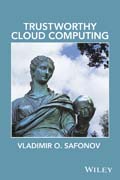
Introduces the topic of cloud computing with an emphasis on the trustworthiness of cloud computing systems and services This book describes the scientific basis of cloud computing, explaining the ideas, principles, and architectures of cloud computing as well the different types of clouds and the services they provide. The text reviews several cloud computing platforms, including Microsoft Azure, Amazon, Oracle, Google, HP, IBM, Salesforce, and Kaavo. The author addresses the problem of trustworthiness in cloud computing and provides methods to improve the security and privacy of cloud applications. The end–of–chapter exercises and supplementary material on the book?s companion website will allow readers to grasp the introductory and advanced level concepts of cloud computing. Examines cloud computing platforms such as Microsoft Azure, Amazon, Oracle, Google, HP, IBM, Salesforce, and Kaavo Analyzes the use of aspect–oriented programming (AOP) for refactoring cloud services and improving the security and privacy of cloud applications Contains practical examples of cloud computing, test questions, and end–of–chapter exercises Includes presentations, examples of cloud projects and other teaching resources at the author s website (http://www.vladimirsafonov.org/cloud) Trustworthy Cloud Computing is written for advanced undergraduate and graduate students in computer science, data science, and computer engineering as well as software engineers, system architects, system managers, and software developers new to cloud computing. INDICE: Preface .Introduction 1 .The cloud as innovative change of computing paradigm 1 .The basic idea of the cloud and its advantages 2 .Issues of the cloud approach and of its learning 4 .Elements of the cloud approach already in use 6 .Next steps of cloud development and their issues 7 .Interest to cloud from different categories of specialists and communities 8 .Exercises to Introduction 10 .Chapter 1 Principles and concepts of cloud computing 12 .1.1 Kinds of modern software architectures 12 .1.2 Characteristic features of modern software 15 .1.3 Basic concepts of modern software architecture 16 .1.4 Service–oriented architecture (SOA) 20 .1.5 Software as a Service (SaaS) 22 .1.6 Key ideas and principles of cloud computing 23 .1.7 Components of cloud platforms and kinds of cloud servicing 25 .1.8 Layers of the cloud architecture 29 .1.9 Scheme of architecture of the cloud 31 .1.10 Roles of people in cloud computing 32 .1.11 Standards of cloud computing 34 .1.12 How the clouds come true: organization of data centers and cloud hardware 39 .1.13 Specifics and components of software for cloud computing 42 .1.14 Cloud computing related trends, activities and resources 46 .1.15 Exercises to Chapter 1 52 .Chapter 2 Platforms of cloud computing 59 .2.1 A variety of cloud platforms. The first impressions 59 .2.2 Amazon AWS cloud platform – a pioneer of cloud computing 64 .2.3 IBM Cloud 74 .2.4 Oracle Cloud 82 .2.5 Google Cloud Platform 88 .2.6 HP Helion cloud platform 93 .2.7 Salesforce cloud platform 101 .2.8 Exercises to Chapter 2 107 .Chapter 3 Principles and pillars of trustworthy computing 111 .3.1 Vital issues of trustworthy computing 111 .3.2 The Trustworthy Computing Initiative by Microsoft 113 .3.3 The security pillar 116 .3.4 The reliability pillar 122 .3.5 The privacy pillar 125 .3.6 The business integrity pillar 128 .3.7 Tools and software lifecycle models to support trustworthy computing 132 .3.8 Exercises to Chapter 3 138 .Chapter 4 Making cloud computing trustworthy 142 .4.1 Psychological barriers between the customers and the cloud, and the ways to overcome them 142 .4.2 User interface for cloud computing, its convenience, usability and functionality for trustworthy cloud computing 145 .4.3 Threats and attacks to clouds 150 .4.4 Trustworthy cloud computing from hardware side: datacenter architecture, servers, clusters, hypervisors 157 .4.5 Trustworthy cloud computing from operating system side: desirable OS features to implement clouds and datacenters 160 .4.6 Using aspect–oriented programming for refactoring cloud services and making them trustworthy: The contribution of St. Petersburg University 165 .4.7 Exercises to Chapter 4 187 .Chapter 5 Example of a trustworthy cloud computing platform in detail: Microsoft Azure 193 .5.1 Overview of Microsoft Azure architecture and its evolution 193 .5.2 User interface and the management portal of Microsoft Azure 198 .5.3 The Compute component: managing and operating cloud services 208 .5.4 The Storage component: managing and operating cloud storage 221 .5.5 The SQL Azure component: the cloud database 230 .5.6 Networking in the Azure cloud: Network–as–a–Service (NaaS), Content Delivery Network (CDN), Virtual Network, Traffic Manager 238 .5.7 Active Directory in the cloud: a way of structuring user accounts 243 .5.8 Development of Microsoft Azure cloud services with Visual Studio 247 .5.9 Visual Studio Online and its relation to Microsoft Azure 256 .5.10 Developing mobile services and connected mobile applications for Microsoft Azure 261 .5.11 Media services 274 .5.12 The .NET platform – the basis of Azure implementation 277 .5.13 Azure tools 292 .5.14 Machine learning in the cloud: Azure Machine Learning Studio 296 .5.15 Parallel processing of big data in the cloud: Using Apache Hadoop in Microsoft Azure 302 .5.16 Perspectives of Microsoft Azure 305 .5.17 Exercises to Chapter 5 306 .Conclusions: Perspectives of trustworthy cloud computing 314 .C.1 Integration of clouds: The Intercloud IEEE Standard 314 .C.2 The TClouds project by European Union 330 .C.3 Further developments and trends of trustworthy cloud computing 344 .C.4 Exercises to Conclusions 351 .Appendix Example of Microsoft Azure cloud service: FileManager 355 .References 368 .Index 379
- ISBN: 978-1-119-11350-8
- Editorial: Wiley–Blackwell
- Encuadernacion: Cartoné
- Páginas: 352
- Fecha Publicación: 28/03/2016
- Nº Volúmenes: 1
- Idioma: Inglés
